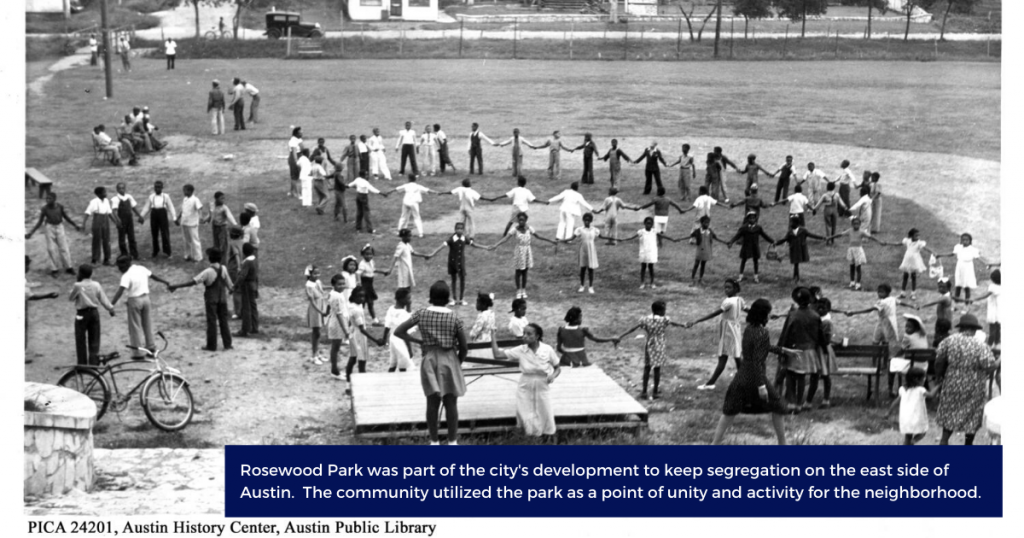Nestled in East Austin, Rosewood Park is a gem in the Texas neighborhood and municipal park system. While its initial development reflects a time of segregation and city planning policies designed to perpetuate racial injustices, Rosewood Park and the community it serves have utilized this resplendent public space to bring health, wellness and solidarity to the community.

The city of Austin instigated The 1928 Plan, which put forth city planning and development to institutionalize racial segregation and to systematically move African-Americans to the east side of Austin. The Bertram-Huppertz estate located along Boggy Creek was purchased to serve the African-American community as a park, and in 1929 Rosewood Avenue Park and Playground for the Colored became the hub for civic, sports, cultural and recreational activities. As one of the only green spaces available to African-American Austinites, Rosewood Park became a vital and central component to the quality of life on the east side of Austin.

The homestead of the Bertram-Huppertz estate was converted into a recreation center for the community and after-school programs were hosted there in 1929. In the 1930s, the Austin Park and Recreation Department began to more fully develop the park, adding tennis courts, a baseball field, more open spaces, a bandstand and picnic tables. The city of Austin named the facility the Delores Duffie Recreation Center in 2014. Delores Duffie is an activist in Austin, who has worked hard for equal education opportunities and adequate housing for members of her community. Her work alongside many others have continued to keep Rosewood Park a treasured cornerstone of recreation in East Austin and has help augment the quality of life for the community’s residents.

In 1942, the City of Austin with the Civilian Conservation Corps built an auditorium as an amenity to the park and named it after Doris “Dorie” Williams, a hero at Pearl Harbor, and the first African-American recipient of the US Navy’s highest honor, the Navy Cross. Doris Willis Auditorium was initially built to host African-American servicemen during WWII and served as an event center for entertainment for soldiers on leave. After WWII, the facility became a key performance space that hosted performances from artists like Ella Fitzgerald, Ike and Tina Turner.

In the 1973, the home of Henry Green Madison was relocated off it’s original site on East 11th Street to Rosewood Park. Henry Green Madison was Austin’s first African-American City Council representative, a farmer and police officer. A designated state landmark, the small log cabin (built in 1964) stands steps away from the Rosewood pool and splash pad.

Rosewood Park continues to be a treasured amenity for the residents of East Austin. From hosting events such as Austin’s annual Juneteenth celebrations to hip-hop shows to providing educational, recreation and leisure activities to the unique and vibrant East Austin community, Rosewood Park has risen beyond the city’s complicated racial

history and continues to serve as a resource for the growth and development of the community.

Articles
“Rosewood Park: History Spotlight” from eastsideatx.com
“The History of Rosewood Park” from Austin Parks Foundation
“August Park of the Month: Rosewood Park” from austintexas.gov
“Austin Splash Pads” from austinmoms.com
“Rosewood Neighborhood Park: Virtual Dedication” Austin Parks and Recreation Department

